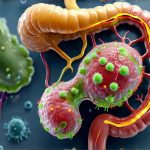Aging is an inevitable process for all living organisms, characterized by a gradual decline in physiological functions and increased susceptibility to disease. While genetics undeniably play a role, recent scientific discoveries have illuminated the profound impact of lifestyle factors on how we age. Among these factors, the composition and function of our gut microbiota – the trillions of microorganisms residing within our digestive tract – are emerging as key determinants of healthy aging and longevity. This complex ecosystem isn’t merely a passive bystander; it actively participates in numerous physiological processes that influence everything from immune function to cognitive health, and its disruption is increasingly linked to age-related chronic diseases.
The relationship between gut microbiota and aging is bidirectional: changes associated with aging impact the gut microbiome, and conversely, alterations in the gut microbiome accelerate or mitigate aspects of the aging process. As we age, diversity within the gut often declines – a phenomenon known as dysbiosis – leading to reduced resilience against pathogens and compromised metabolic functions. Understanding this interplay is crucial for developing strategies that promote “aging gracefully,” not necessarily by halting the inevitable march of time, but by maximizing healthspan – the period of life spent in good health. This article will explore the intricate connections between gut microbiota, inflammation, and aging, providing insights into how we can cultivate a healthier gut to support a longer, more vibrant life.
The Gut Microbiota’s Role in Inflammation & Aging
Inflammation is a natural and necessary process for healing and defense against injury or infection. However, chronic low-grade inflammation, often referred to as “inflammaging,” is a hallmark of aging and contributes significantly to the development of age-related diseases like cardiovascular disease, type 2 diabetes, Alzheimer’s disease, and cancer. The gut microbiota plays a central role in modulating systemic inflammation levels. A healthy, diverse microbiome helps maintain the integrity of the intestinal barrier – often described as the gatekeeper between our gut and the rest of our body – preventing what’s known as “leaky gut”.
When this barrier is compromised due to dysbiosis or other factors, bacterial components like lipopolysaccharide (LPS) can leak into the bloodstream, triggering an immune response and contributing to systemic inflammation. Conversely, certain beneficial bacteria produce short-chain fatty acids (SCFAs) – such as butyrate, propionate, and acetate – through the fermentation of dietary fiber. SCFAs have potent anti-inflammatory properties, strengthen the gut barrier, and even influence immune cell function, helping to regulate the inflammatory response. The balance between pro-inflammatory and anti-inflammatory microbial activity is thus critical for maintaining health throughout life.
A key aspect of this relationship is the modulation of the immune system. The gut microbiome profoundly influences both innate and adaptive immunity. It “educates” the immune system early in life, helping to distinguish between harmless commensal bacteria and potentially harmful pathogens. As we age and microbial diversity declines, this education process can become disrupted, leading to an overactive or misdirected immune response that contributes to chronic inflammation. Maintaining a healthy gut microbiome is therefore essential for ensuring appropriate immune function throughout the lifespan. Considering the impact of the microbiome on immunity, it’s important to understand gut biome diversity as well.
Dietary Strategies for Gut Health & Longevity
The food we consume has a direct and profound impact on the composition of our gut microbiota. A diet rich in plant-based foods, particularly those high in fiber, provides fuel for beneficial bacteria, promoting their growth and diversity. Conversely, diets high in processed foods, sugar, and saturated fats can disrupt the microbiome, favoring the proliferation of pro-inflammatory species. Embracing a dietary pattern focused on whole, unprocessed foods is arguably one of the most impactful steps we can take to support gut health and promote healthy aging.
Specifically, prebiotics – non-digestible fibers that selectively feed beneficial bacteria – are crucial for nurturing a thriving microbiome. Excellent sources include onions, garlic, leeks, asparagus, bananas, oats, and apples. Similarly, probiotics – live microorganisms found in fermented foods like yogurt, kefir, sauerkraut, kimchi, and kombucha – can help replenish beneficial bacteria populations. However, the effects of probiotics are often strain-specific, and their benefits may vary depending on individual gut composition. It’s important to remember that probiotic supplements aren’t a one-size-fits-all solution; dietary sources generally offer a more sustainable and diverse approach. The relationship between the microbiome and conditions like diabetes highlights the importance of a healthy gut.
Beyond prebiotics and probiotics, polyphenols – naturally occurring compounds found in fruits, vegetables, tea, coffee, and dark chocolate – have also been shown to positively influence gut microbiota composition and function. Polyphenols are not well-absorbed in the upper digestive tract, allowing them to reach the colon where they are metabolized by gut bacteria into beneficial metabolites with anti-inflammatory properties. This highlights the importance of a diverse and colorful diet for supporting both gut health and overall wellbeing.
The Role of Fiber Intake
Fiber is arguably the most important dietary component for gut health. It’s not digested in the small intestine, instead traveling to the colon where it becomes food for our microbial partners. Different types of fiber support different bacterial communities, contributing to overall microbiome diversity. – Soluble fiber (found in oats, beans, and apples) attracts water, forming a gel-like substance that slows down digestion and promotes feelings of fullness. It also feeds bacteria that produce butyrate, a key SCFA with anti-inflammatory properties. – Insoluble fiber (found in whole grains, vegetables, and fruits with skin) adds bulk to stool, aiding in regular bowel movements and preventing constipation.
Increasing fiber intake should be gradual to avoid digestive discomfort like bloating or gas. It’s also essential to drink plenty of water to help the fiber move through the digestive system efficiently. Aiming for at least 25-30 grams of fiber per day is a good starting point, but individual needs may vary. Focusing on whole food sources of fiber – rather than relying solely on supplements – provides additional nutrients and promotes a more balanced gut ecosystem. You might also find it helpful to address issues like digestive gas with dietary changes.
Managing Stress & Gut Health
The gut microbiome isn’t just influenced by diet; it’s also intimately connected to our nervous system through the gut-brain axis. Chronic stress can significantly disrupt this bidirectional communication, leading to alterations in gut microbiota composition and increased intestinal permeability – contributing to inflammation and compromised immune function. Stress hormones like cortisol can directly impact the microbiome, favoring the growth of pro-inflammatory bacteria while suppressing beneficial species.
Implementing stress management techniques is therefore crucial for maintaining a healthy gut. These include: – Mindfulness meditation – Regular exercise – Deep breathing exercises – Spending time in nature – Prioritizing sleep – aim for 7-9 hours per night. Furthermore, practices like yoga and tai chi have been shown to reduce stress levels and positively influence gut microbiota composition.
The Future of Gut Microbiome Research & Aging
Research into the gut microbiome is rapidly evolving, revealing new insights into its role in aging and disease. Emerging technologies like metagenomics – the study of microbial genomes – are allowing scientists to characterize the complex microbial communities within our guts with unprecedented precision. This knowledge is paving the way for personalized interventions tailored to individual microbiome profiles.
Future strategies may involve: – Fecal microbiota transplantation (FMT) – transferring fecal matter from a healthy donor to restore microbial diversity in individuals with dysbiosis, although this remains an experimental approach and isn’t widely available. – Development of precision probiotics – designed to target specific bacterial strains based on individual needs. – Dietary recommendations personalized based on microbiome analysis. – Therapies targeting the gut-brain axis to mitigate the impact of stress on gut health. While much research is still needed, the potential for harnessing the power of the gut microbiome to promote healthy aging and extend healthspan is immense. Understanding how our digestive system interacts with other bodily functions can also help explain cold symptoms and their impact on gut health. And don’t forget to consider the connection between your gut and conditions such as migraines.


















